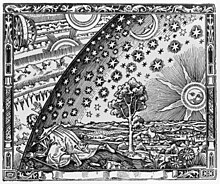Camille Flammarion
[5] As a young man, Flammarion was exposed to two significant social movements in the western world: the thoughts and ideas of Darwin and Lamarck and the rising popularity of spiritism with spiritualist churches and organizations appearing all over Europe.
[6] He was influenced by Jean Reynaud (1806–1863) and his Terre et ciel (1854), which described a religious system based on the transmigration of souls believed to be reconcilable with both Christianity and pluralism.
[8] In Real and Imaginary Worlds (1864) and Lumen (1887), he "describes a range of exotic species, including sentient plants which combine the processes of digestion and respiration.
This belief in extraterrestrial life, Flammarion combined with a religious conviction derived, not from the Catholic faith upon which he had been raised, but from the writings of Jean Reynaud and their emphasis upon the transmigration of souls.
Man he considered to be a “citizen of the sky,” other worlds “studios of human work, schools where the expanding soul progressively learns and develops, assimilating gradually the knowledge to which its aspirations tend, approaching thus evermore the end of its destiny.”[9] His psychical studies also influenced some of his science fiction, where he would write about his beliefs in a cosmic version of metempsychosis.
In Lumen, a human character meets the soul of an alien, able to cross the universe faster than light, that has been reincarnated on many different worlds, each with its own gallery of organisms and their evolutionary history.
"[10] In the English translation of Lumen, Brian Stableford argues that both Olaf Stapledon and William Hope Hodgson have likely been influenced by Flammarion.
Camille was a brother of Ernest Flammarion and Berthe Martin-Flammarion, and uncle of a woman named Zelinda.
[12] As American astronomer Percival Lowell, he thought the "canals" were artificial in nature and most likely the "rectification of old rivers aimed at the general distribution of water to the surface of the continents.
"[13] He assumed the planet was in an advanced stage of its habitability, and the canals were the product of an intelligent species attempting to survive on a dying world.
On 1 February 1910, Flammarion published an update in the Herald, saying he wished to warn journalists against "accusing me of announcing the end of the world for May 19 next.
[21] His book The Unknown (1900) received a negative review from the psychologist Joseph Jastrow who wrote "the work's fundamental faults are a lack of critical judgment in the estimation of evidence, and of an appreciation of the nature of the logical conditions which the study of these problems presents.
"[22] After two years investigation into automatic writing he wrote that the subconscious mind is the explanation and there is no evidence for the spirit hypothesis.
[27] The book was reviewed by the magician Harry Houdini who wrote it "fails to supply adequate proof of the veracity of the conglomeration of hearsay it contains; it must, therefore, be a collection of myths.
"[28] In a presidential address to the Society for Psychical Research in October 1923 Flammarion summarized his views after 60 years of investigating paranormal phenomena.
He wrote that he believed in telepathy, etheric doubles, the stone tape theory and "exceptionally and rarely the dead do manifest" in hauntings.


